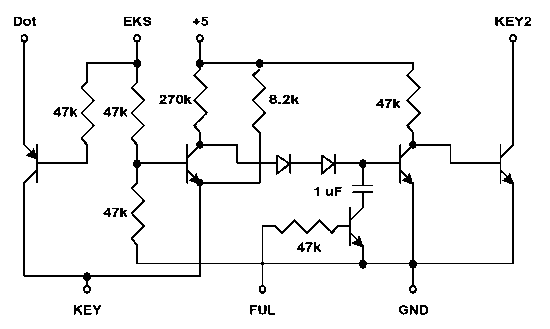The TS-950 is known to have inaccurate CW keying weighting, especially in the full QSK mode. While investigating the use of the 950 as a transmitter for an ionospheric reflection measurement by several of my students, I noticed that there was substantial jitter in the keying. This was traced to the electronic keyer, which seems to be active in some way even when the keyer switch is off. This variation in keying delay and character length has been bothering me ever since I bought the 950 (you would think that, for the price, the manufacturer would have resolved this issue before releasing the product).
The jitter results in a variable delay of the leading edge of about 3 msec and of the trailing edge of about 6 msec, so it was not possible to go in parallel around the keyer and still have good timing. I experimented with a circuit that included a switch to direct the paddle or keyer input either directly to the electronic keyer output (keyer OFF) or its input (keyer ON). This solved the jitter problem and resulted in very satisfactory timing for semi-QSK (without requiring the 1 uF shunt capacitor that I have used for many years. In order to correct the timing for QSK, I added a transistor switch that adds a capacitor to create a delay on the keying trailing edge. To separate KEY input at the connector and Dot (CN32), I removed one of the 100 ohm surface mount resistors on the keyer; KEY2 is at the keyeroutput connector or at CN33 on the mother board. By removing the dash resistor and swapping the wires at the 3-pin input connector, you could swap dot and dash per K6XX.
The circuit here does the job; no doubt someone can develop a more elegant approach using IC NOR gates and the like. At 32 words per minute, the external keyer dot baud length is 30 msec, and the transmitted signal is about 2 msec longer than the keying waveform on semi-QSK and within 1 msec of the keying waveform on full QSK.

The circuit is constructed with point-to-point wiring and placed in a small plastic bag to prevent shorts when the front panel is reclosed. A ribbon cable is soldered to the appropriate terminals on the 950 electronic keyer daughter board, and all works well.
|
